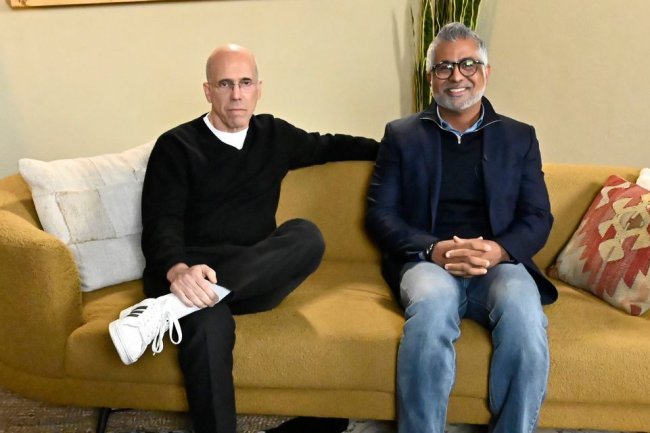The Longevity Clinic Will See You Now—for $100,000
The clinics cater to a growing number of people obsessed with fighting aging Photo illustration by Rachel Mendelson/The Wall Street Journal, iStock (2) Photo illustration by Rachel Mendelson/The Wall Street Journal, iStock (2) By Alex Janin July 10, 2023 9:00 pm ET Medical clinics are popping up across the country promising to help clients live longer and better—so long as they can pay. Longevity clinics aim to do everything from preventing chronic disease to healing tennis elbow, all with the goal of optimizing patients’ health for more years. Clients pay as much as $100,000 a year for sometimes-unproven treatments, including biological-age testing, early cancer screenings, stem-cell therapies and h


Medical clinics are popping up across the country promising to help clients live longer and better—so long as they can pay.
Longevity clinics aim to do everything from preventing chronic disease to healing tennis elbow, all with the goal of optimizing patients’ health for more years. Clients pay as much as $100,000 a year for sometimes-unproven treatments, including biological-age testing, early cancer screenings, stem-cell therapies and hair rejuvenation.
The centers capitalize on Americans’ obsession with living longer and desire for personalized medical care, even if it comes from outside the mainstream, say industry investors and analysts.
Many doctors and scientists caution that some clinics’ treatments lack robust scientific evidence or introduce health risks.
“It’s not a regulated market. Anybody who is treating your toenails can say they’re contributing to longevity,” says aging researcher Dr. Andrea Maier, who heads a nonprofit group working to establish medical standards around longevity medicine. Maier also runs a longevity clinic in Singapore focused on treatments backed by human trials.
People who visit these clinics are generally comfortable taking risks on health treatments, practitioners say. They are often wealthy people in their 40s to 60s who are seeing signs of aging. Several providers say they have noticed clientele trending as young as 20-somethings in recent years.
No official count of longevity clinics exists, but estimates range from roughly 50 to 800 in the U.S., longevity researchers, doctors and analysts say.
Venture-capital investment in longevity clinics more than doubled between 2021 and 2022, from $27 million to $57 million globally, according to analysis from longevity research and media company Longevity.Technology. Roughly 70% of global investment in longevity clinics happens in the U.S., says Phil Newman, Longevity.Technology’s editor in chief.
“There are a lot of millionaires and billionaires that are trying to enjoy their wealth as long as they possibly can,” says Newman.
The patient experience
Clinics typically start patient visits by assessing their goals: Do they want to live longer, lose weight or manage symptoms of a health condition? Providers follow up with blood, skin and urine testing, as well as taking standard metrics such as height, weight and blood pressure.
Longevity doctors sometimes recommend early cancer screenings, body imaging such as MRI scans, and cognitive testing, to determine a baseline of current health as well as detect early-stage problems. Some providers recommend patients use wearables to monitor metrics such as resting heart rate or sleep quality.
The services don’t come cheap.
Practitioners at Healthy Longevity Clinic, which has locations in Boca Raton, Fla., and Prague, build patients a personalized “longevity road map.” Those maps can include recommendations for diet, exercise, sleep and supplements. Patients are encouraged to stick with the program for at least a year, over which time their bill can run between $25,000 to more than $100,000, says Petr Sramek, the clinic’s chief executive.
Longevity-clinic treatments aren’t often covered by health insurance. Some providers say they work with insurers to get coverage for medications or laboratory tests.
Many clinics use membership-based models in an effort to keep client loads low enough that providers can spend time with each patient. Others are fee-for-service or use a combination of the two.

Anita Wheaton, with husband Rod Wheaton, says the $2,800 annual fee for her telehealth longevity practice is worth it.
Photo: Hannah and Leah Photography
Anita Wheaton, a 53-year-old life insurance agent in Tampa, Fla., says the $2,800 annual price tag to become a member of a telehealth longevity practice is worth the attention she gets from her provider. The membership doesn’t include prescriptions and laboratory testing.
Under the supervision of her longevity practitioner at the Virginia-based clinic Everest Health over the past year, Wheaton says she has tried various supplements and drugs, plus temporarily cut alcohol and meat from her diet. The changes have helped her manage endometriosis and the autoimmune disorder Hashimoto’s disease, and drop more than 30 pounds.
“You spend money on what you want, and quality of life is worth it to me,” says Wheaton. “To not just live longer, but live healthier.”
Everest Health founder Danielle Ruiz says the practice focuses on evidence-based treatments but also aims to stay on the “cutting edge of science.” That might include treatments that traditional medical guidelines haven’t yet adopted, such as certain supplement recommendations and off-label medication prescriptions, she says.
Weighing risks
Traditional-medicine doctors caution that so many tests can lead to overdiagnosis, detecting conditions such as benign tumors that aren’t likely to cause harm, leading to unnecessary costs and procedures.
Scientists also question the safety and effectiveness of certain treatments offered by some longevity clinics, such as non-FDA-approved therapies such as stem-cell rejuvenation.
Clinics are marketing stem-cell therapies, for instance, for everything from boosting cells’ regenerative abilities to improving libido. The Food and Drug Administration has approved only a handful of stem-cell treatments, mainly for blood and immune disorders. Risks of unapproved treatments include bacterial infections and tumor growth.
“People often try these products based on the rationale, ‘Well, it’s not going to hurt me,’” says Sean Morrison, former president of the International Society for Stem Cell Research. “But there is a cost to these products beyond the fact that you’re spending thousands of dollars on something that we wouldn’t expect to benefit you.” People have ended up in the hospital with sepsis because products they were injected with contained bacteria, he says.
Looking for alternatives
Erin King, a 48-year-old real-estate adviser in Jacksonville, Fla., began exploring nontraditional medicine in his early 40s, when he felt tired more often and wanted alternatives to the statin medication he says his primary-care doctor suggested.
King says his energy levels improved after starting testosterone injection treatments at Anderson Longevity Clinic, which has four U.S. locations.
SHARE YOUR THOUGHTS
Would you join a longevity clinic? Why or why not? Join the conversation below.
He also says a sports-related elbow strain improved after he received a treatment called prolotherapy, which involves injections of a solution of sugar and saline or lidocaine. The treatment, which isn’t approved by the FDA, is used to relieve pain in muscles or tendons.
King has since made the clinic’s founder and medical director, Dr. Brian Anderson, his primary-care provider. Anderson says some prolotherapy patients have felt improvements from tennis elbow, and that other experimental treatments have helped people look and feel younger and sleep better.
“I feel like [regular doctors] are overworked, have too many clients and they don’t sit down and read my files,” says King. “I wanted to get a different look.”
Write to Alex Janin at [email protected]
What's Your Reaction?

















